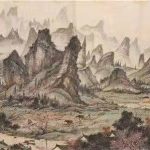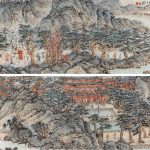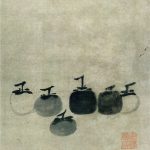The Image Colour in Chinese Painting
Issue 3 – By; Ning Lizheng 宁立正, Feng Fengju 冯凤举
Colour is an inherent attribute of nature and also one of the basic languages of painting. It is used to show the artistic style of the picture and to express and convey the artist’s emotion. Colour does not exist only in Western paintings, it also attracts Chinese people in painting in many aspects.
In the history of Chinese art, as early as 10,000 years ago, in the Neolithic Age, China had many painted pottery patterns, silk paintings existed in the Warring States 战国 period and murals in Han and Wei Tomb 汉魏墓.
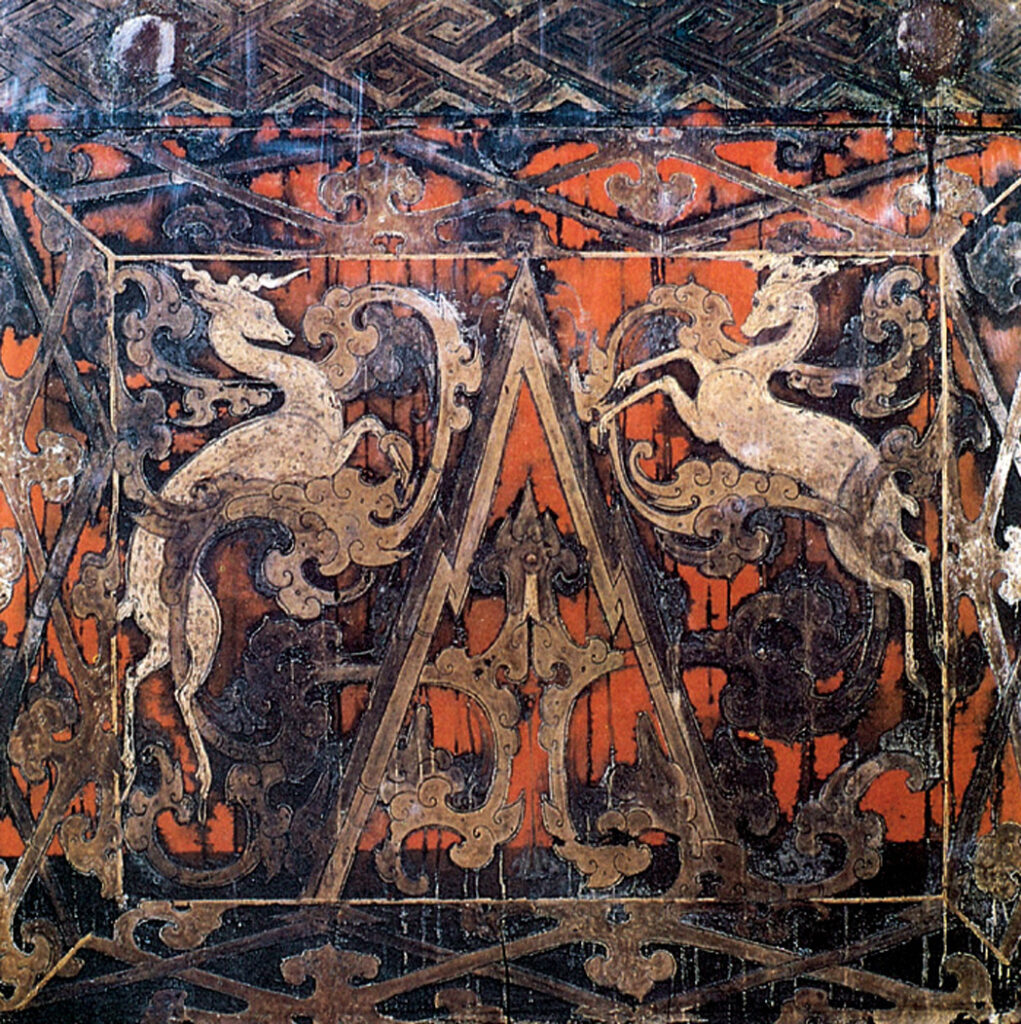
All those artistic creations are colourful. During the period of Wei and Jin 魏晋 dynasties, Buddhism spread eastward and grotto statues prevailed. The colourful Mogao Grottoes 莫高窟 in Dunhuang 敦煌 have become one of the largest art treasures in the art history of the world. The application of heavy colours for Jinbi Mountain and Water painting 金碧山水画 of Sui and Tang Dynasty 隋唐 was neat, refined and rich. The Flower and Bird Painting 花鸟画 was mature. Especially, Huang Quan’s 黄筌 (about 903-965) flower and bird paintings were dazzling. The traditional Chinese painting has formed an extraordinary rich colour system in its continuous practice.
With the development of human civilization, people have different views on colour, forming different colour concepts in China and the West. The colour of Western painting comes from the natural scientific cognition of the world, which is based on the visual experience. In art, it is expressed as the reproduction of the objective world. The early formation of colour system before the Song Dynasty宋代 in China was based on the original colours. Later, the Ink and Wash Painting 水墨画 in Song Dynasty gradually became the mainstream of Chinese painting. And the rise of literati landscape painting carried on a bold innovation on the colour language of the traditional Chinese painting in the process of “being refined”, forming a unique colour system mainly depending on black and white. In Chinese painting, painters pay more attention to the expression of their own emotions. The colours in paintings do not aim to restore or imitate anything, but to express something. It is the image colour from a mysterious colour view of dialogue between human and nature.
1 .The colour view of the traditional Chinese painting
Different from the scientific view of colour in the Western classical paintings, the Chinese colour culture, with a mysterious philosophy, is enveloped in the traditional philosophy of image aesthetic category, paying attention to vivid portrayal, to paint from real objects and to establish images to express emotions.
1.1. Philosophical soil
The use of colours in Chinese painting is inclined to subjectivity with its unique historical culture and philosophical soil. Confucianism in the pre-Qin period 先秦时期 explained the traditional “rites and music” with rational spirit. In terms of the cognition of colour, it affirmed the subjective character of the objective existence of colour. Confucius and Zi Xia子夏 (507-420) had a wonderful dialogue as a proof:
“The light smiling face so pretty, the black-and-white distinction eyes so beautiful, like a splendid picture on the blank paper, how to understand all these?”The Master said, “The blank paper first, then colour on it.”
巧笑倩兮,美目盼兮,素以为绚兮,何谓也?”子曰:“绘事后素。[1]
The woman smiles really sweet with bright eyes because she makes up with the plain powder. The plain silk was ready first, and then the image of a beautiful woman was painted on it. The whole painting was a perfect combination of the image and the plain silk. In other words, there is no need to copy the colour of the aesthetic object when painting, but arranging the colours subjectively according to the needs of the picture.
1.2. The combination of colour and ink
Lao Zhuang’s philosophy advocated plain simplicity, opposed to gorgeous luxuries. His mysterious belief was that “painting is the image from the mind, and colour is the sound from the heart” 画为心象,色为心声[2]. The sayings “Various colours make people blind” 五色令人目盲[3] and “colourless painting makes colourful” 无色而五色成焉[4] remind people to get rid of the luxuriant colours of the surface of the object image, with the style of simplicity to express one’s innocence in the creation of art. Therefore, in ancient China, black was a popular colour for a long time. But in Chinese painting, ink is not only regarded as black. It is separated into five different colours. The change of intensity in ink is the change of colour. However, in ancient China, with ink, painters expressed the essence of natural images in landscape paintings. Whereas painted pottery, tomb murals, lacquer paintings, Buddhist sculptures, figure paintings, flower-and-bird paintings and New Year pictures took brilliant colours as the main style, different from ink and wash paintings.
1.3. The integration of calligraphy and painting
The concept of brush and ink in Chinese painting appeared after calligraphy consciously intervened in painting. During the Wei and Jin dynasties, literati and scholar-officials combined aesthetic taste with various types of characters. Since then the calligraphy flourished. The use of calligraphy in the Chinese painting reduced the status of colour to some extent. Most of the ancient literati and painters had a preference for the implication, simplicity, freshness, lightness; they were painting with clear and simple colours, being immune to the ordinary world in order to see themselves as being high quality and extraordinary. After the introduction of Buddhism to the Eastern Han Dynasty东汉, some painters pursued the Chan (Zen) idea禅意 and advocated the use of Chan in colour. “Colour does not differ from emptiness. Emptiness does not differ from colour. Colour is emptiness. And emptiness is colour.” 色不异空,空不异色,色即是空,空即是色.[5] The connotation of colour is richer and its extension is broader.

1.4. Colour according to the objects
In his “Six Approaches” liufa六法, Xie He谢赫 (479-502) in the Southern Dynasty 南朝 put forward the “colour according to the objects” 随类赋彩, which cannot be simply understood as “colour” according to the absolute colour of the objects. The so-called “object” should be understood as similarity or approximates. It emphasizes that the painter should observe the essence and spirit of objective figures comprehensively, so as to blend things with myself, then create a unique colour realm with the artist’s imagination.
2. The modern expansion of the concept of the use of colour in the traditional Chinese painting
The relationship between ink and colour in the Chinese painting has been debated continuously since ancient times. Some people advocate emphasizing ink over colour, while others advocate emphasizing colour over ink. It is difficult to tell which judgment is more superior. At the end of the Qing Dynasty 清朝, Western painting ideas had a great impact on the inherent concept of the Chinese painting colour. Painters were at a loss and they tried to make a deep exploration of the Western painting, and tried to introduce the western concept of colour into Chinese painting. And gradually, the concept of colour of Chinese painting did broaden.
2.1. Look up to ink and down to colour
Dong Qichang 董其昌 (1555-1636) in Qing Dynasty advocated the use of ink, clear, clean, mild, simple, light, with green colour, plain and elegant. “The rhyme is born from light painting”, “Traces can be hardly seen when colour is used slightly.” Zou Yigui 邹一桂 (1686-1772) in Qing Dynasty advocated maintaining the transparency of ink, believing that too much rendering would weaken the transparency of the ink and brush, the personality and the interest of the painting. He once said: “Colour should be light rather than heavy. Because if it is heavy, it will be sluggish and ineffective, sticky but unsmooth.”

2.2. Pay equal attention to colour and ink
Sheng Da Shi 盛大士 (1771-1836) of the Qing Dynasty advocated the complementarity of ink and colour. He believed that the combination of large area moistening and concentration of ink and colour. While maintaining the expression of ink and brush, heavily painted in some parts, strengthen the visual contrast effect of colour and ink, so as to achieve the perfect unity of the two effects of large ink and partial pure colour. Zhang Daqian 张大千 (1899-1983) travelled around the world and once discussed art with Picasso. He was known as the “Oriental Brush” in the western art circle. Though he learned from the ancient world, he never imitated it, and continuously innovated on the basis of inheriting the tradition. In the aspect of colour, Zhang Daqian learned the original colour of the objects but didn’t copy them. Instead, he made full use of the texture effect formed by water, ink and colour on the Xuan paper 宣纸 with great passion. He used colour according to the type of image and even the “pleasure”. He created the art of splashing colour and the splashing colour and ink, and opened up a new form of art.

2.3. The Combination of the Chinese and the Western paintings
In some of his paintings, Ren Bonian 任伯年 (1840-1895), a Shanghai painter in the late Qing Dynasty, obviously absorbed the colour techniques of the Western art. He stressed on the contrast of colours and the treatment of colour tones, and integrated the inherent colour concept of Chinese paintings from the environmental colours of the Western paintings, thus making the colours of the Chinese paintings richer.

2.4. Contemporary Practice
From the works of a large number of outstanding contemporary Chinese painters such as Lin Fengmian 林风眠 (1900-1991),

Li Keran 李可染 (1907-1989),

Wu Guanzhong 吴冠中 (1919-2010),

painters of Lingnan Painting School 岭南画派 and painters of Lijiang Painting School 漓江画派, we can see the exploration and expression of the relationship between colour and ink has reached a certain height and depth.
Lin Fengmian often depicted gorgeous subjects in heavy colours. Li Keran, taking nature as his teacher, visited Guilin桂林 many times to explore the relationship between sunshine and ink. And for the first time the concept of the emphasis light in the Western painting was introduced to the Chinese painting. Wu Guanzhong advocated that the colour of the brush and ink should serve the expression of the painter’s thought and emotions. When isolated from the concrete picture, the brush and ink would be meaningless. On the basis of the painting approach of “Hitting the Water and Hitting the Powder” 撞水撞粉by the brothers Ju Chao居巢 (1811-1889), Ju Lian 居廉 (1828-1904) and their disciples Gao Jianfu 高剑父 (1879-1951), Gao Qifeng 高奇峰 (1889—1933) and Chen Shuren 陈树人 (1884-1948) of the Lingnan Painting School accepted the concept of the usage of colour of the Japanese painting and the Western painting and started the reform of colour in the Chinese painting by applying light or heavy colours in the Chinese painting. Huang Gesheng黄格胜 (1950- ), the leading artist of the Lijiang Painting School, believed that “ink does not interfere with colour, colour does not interfere with ink, ink does not interfere with ink, colour does not interfere with colour, colour gets along well with ink.”
墨不碍色,色不碍墨,墨不碍墨,色不碍色,色墨相生[6]

3. The embodiment of image colour in traditional Chinese painting
While painting bamboo, Zheng Banqiao 郑板桥(1693-1766) had three steps: bamboo in the eyes, bamboo in the heart and bamboo in the hand. By observing the bamboo, through the art experience, the painter finally forms a conception of the bamboo image in the heart, and then conveys it to the painting. This distilling process is to make the aesthetic object an image. The painter depicts the object’s shape and colour with his own emotion.
3.1. Images
What is an image? Confucius once said, “A book cannot express the author completely. Language cannot express ourselves completely. So, why can’t the sage author of Zhouyi 周易be completely understood? Confucius said, the sage set up an image to fulfill his purpose.” It tells us to grasp the internal rules of everything through its appearance so as to form a conception yi 意, and finally an image yixiang 意象of it. “Image” here is the harmonious unity of objective form, the subjective spirit and the artist’s interest. It is the unity of subjectivity and objectivity in the integration of subject into object. In short, it is the combination of the painter and his aesthetic objects.
3.2. Image Colour
Image colour refers to the colour application approach created by the artist through the feeling of the colour of the aesthetic object, which is the combination of emotion and the scene, the nature and the human. External learning from nature would form an image in the heart. The artist perceives the objective nature from inside the heart, and converts the internal emotion into the meaningful external image. The aesthetic realm of Chinese art is not to restore nature or to please the eyes, but to express the emotion and express the meaning, and to connect with nature.
3.3. The embodiment of image colour in the Chinese painting
Influenced by Taoism, the image of Chinese painting lies between being and naught, void and reality. In the grasp of the concrete image and the abstract image, this kind of idealistic colour-giving concept is the beauty of compromise based on the artistic spirit of harmonious integration of object and self. From the manners of Wei and Jin 魏晋 in the Six Dynasties六朝 to the luxury of Tang people, the elegance of Song people, the leisure of Yuan people, the humour of Ming people, and the simplicity of Qing people, the long history of Chinese colours always radiates the light of images.
Wang Wei王维 (701-761) was the first artist to create the Pomo破墨ink and landscape painting,which got rid of the grandiose style of the previous landscape paintings. Jing, Guan, Dong, Ju荆关董巨 (Jing Hao 荆浩, Guan Tong 关仝, Dong Yuan 董源, Ju Ran巨然) initiated the North Painting School and the South Painting School. According to the regional characteristics of aesthetic objects in the original ink painting, the characteristics of the north and south landscape were highlighted; the four famous painters in Yuan Dynasty depicted their heart emotion, instead of pursuing realism, just focusing on the artistic conception and verve. Xu Wei 徐渭 (1521-1593) had bad luck all his life. He attempted nine suicides, but all failed. He disliked the daily life and the world. So with his brush, ink and lines, he created depressed and sad works.
4. The current context of the Chinese painting colour
Each country and each era have a corresponding form of artistic expression. Chinese traditional painting in ancient times has the reputation of “Danqing” 丹青. Silk paintings of Mawangdui 马王堆, Dunhuang frescoes 敦煌壁画 made a perfect combination of dark lines and heavy colour. Wei and Jin 魏晋. Southern and Northern Dynasties 南北朝 achieved great things in colour aesthetics. Colour in Tang Dynasty was splendid and perfect. In Song Dynasty, the colour in painting is simple, light and elegant. Thus the use of colour in painting lasted over one thousand years. And then from Qing Dynasty on, things are different.

4.1. Difficult exploration under the background of neo-colonialism
During the late Qing Dynasty, when the colourful paintings of the Western world flowed into China, many painters rethought colour in Chinese painting. They wanted to reform the art world from the use of colours for paintings, coming out from the simple and light world and tried to fit in the new world.
In terms of colour, Ren Bonian used the “vulgar colour”, which is the most taboo of literati painting, and integrated the folk colour painting style and the elements of western watercolour into his works, thus realizing the taste of both being refined and popular. Zhao Zhiqian赵之谦 (1829-1884) tried many colours together, which set off mutually, and showing that Chinese painting had transformed from the traditional to modern context. Xu Beihong 徐悲鸿 (1895-1953) advocated the integrating western classical realism painting techniques into the creation of the Chinese painting on the basis of inheriting traditional Chinese painting, integrating ancient and modern, Domestic and foreign painting styles into one. This plays a connecting role in the history of Chinese art.

4.2. Continued attempts under the background of new ideological trend
With the reform and opening up, the Chinese culture has combined with the western art. The Chinese painting once again faces the influence of “the new ideological trend”. Firstly, the continuation of the traditional ink painting. Adhering to the traditional expression of ink while absorbing western modern composition elements, in a new composition and colour system, artists will find a fluent unity of the emotion and the outside world. Secondly, the experiment of abstract ink painting. In terms of painting materials and tools, we have other choices besides Xuan paper and plain silk, such as other comprehensive materials, which can improve the creation of traditional ink painting.
Chinese painting embraces the world with a broad mind, and identifies, absorbs excellence from the painting art of various nationalities. However, the gene cannot be lost. No matter how, the colour of the essence of the Chinese painting will not change. The expression of the Chinese painting must be the painter’s inner emotion. The expression styles of colour may have the difference between Chinese and Western, old and new, but the colour to express the painter’s “meaning” is not limited to time and space. The ultimate performance of a painter is self-cultivation, talent, tolerance and aesthetic ability. If the painter is only good at skills without inner emotions, then he can only be a painting labour. Only with the understanding of the beauty of “image” can the painter firmly hold the spiritual home of Chinese painting colour.
The Authors: Ning Lizheng 宁立正, Born in Guangxi, China, in 1965. Professor of Guangxi Arts University. Standing Director of Guangxi Translators Association. Mentor for post-graduate students. Member of English Teaching Steering Committee for Undergraduate Institutions of Guangxi. Member of Teaching Steering Committee of Guangxi Arts University. His publications include: 100 years of Chinese Oil Painting, Son of the Mountains–A Study of Art on the Yao Painter Zheng Junli’s Painting, A Survey of the Masters and Masterpieces of the Lijiang Painting School.
Feng Fengju 冯凤举, Born in Guangxi, China, in 1976. Painter of landscape painting, Theorist of literature and art, Member of Guangxi Artists Association, Distinguished professor of Guangxi-asean Art Research Academy, Standing director or the Promotion Association of Lijiang Painting School, Vice dean of Academy of Architecture Arts of Guangxi Arts University, His achievements include works collected to the Nationwide or Provincial exhibitions,
Publications: Huang Gesheng and Education, Huanggesheng and Lijiang, The Mission of Art
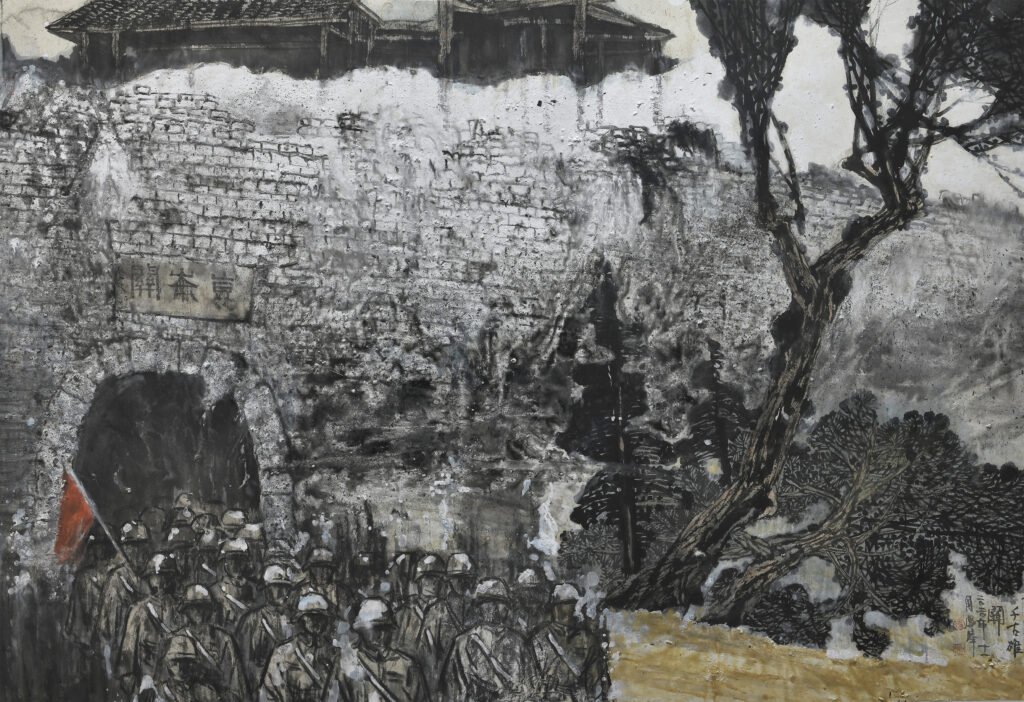
Read the full magazine
[1] Confucius, The Analects of Confucius, the Spring and Autumn Period(孔子,论语,春秋)
[2] Lü Shaoying, Interpretation of the Colour Image in Chinese Painting, Friends of Fine Arts, 2009 (1) (吕少英,《解读中国画色彩的意象》,《美术之友》2009年第1期)
[3] Lao Dan(Lao Zi), Tao De Jing, The Spring and Autumn Period (老聃 老子
《道德经》春秋)
[4] Lao Dan(Lao Zi), Tong Xuan Zhenjing, the Spring and Autumn Period
(老聃 老子《通玄真经》,春秋)
[5] Dharma Master Xuan Zang, Prajna Heart Sutra, Tang Dynasty (玄奘法师《般若心经》 唐)
[6] Feng Fengju, A Collection of Huang Gesheng’s Manuscripts, Guangxi Fine Arts Publishing House, 2021
冯凤举,《问道榕荫楼—黄格胜课稿辑录》,广西美术出版社2021


